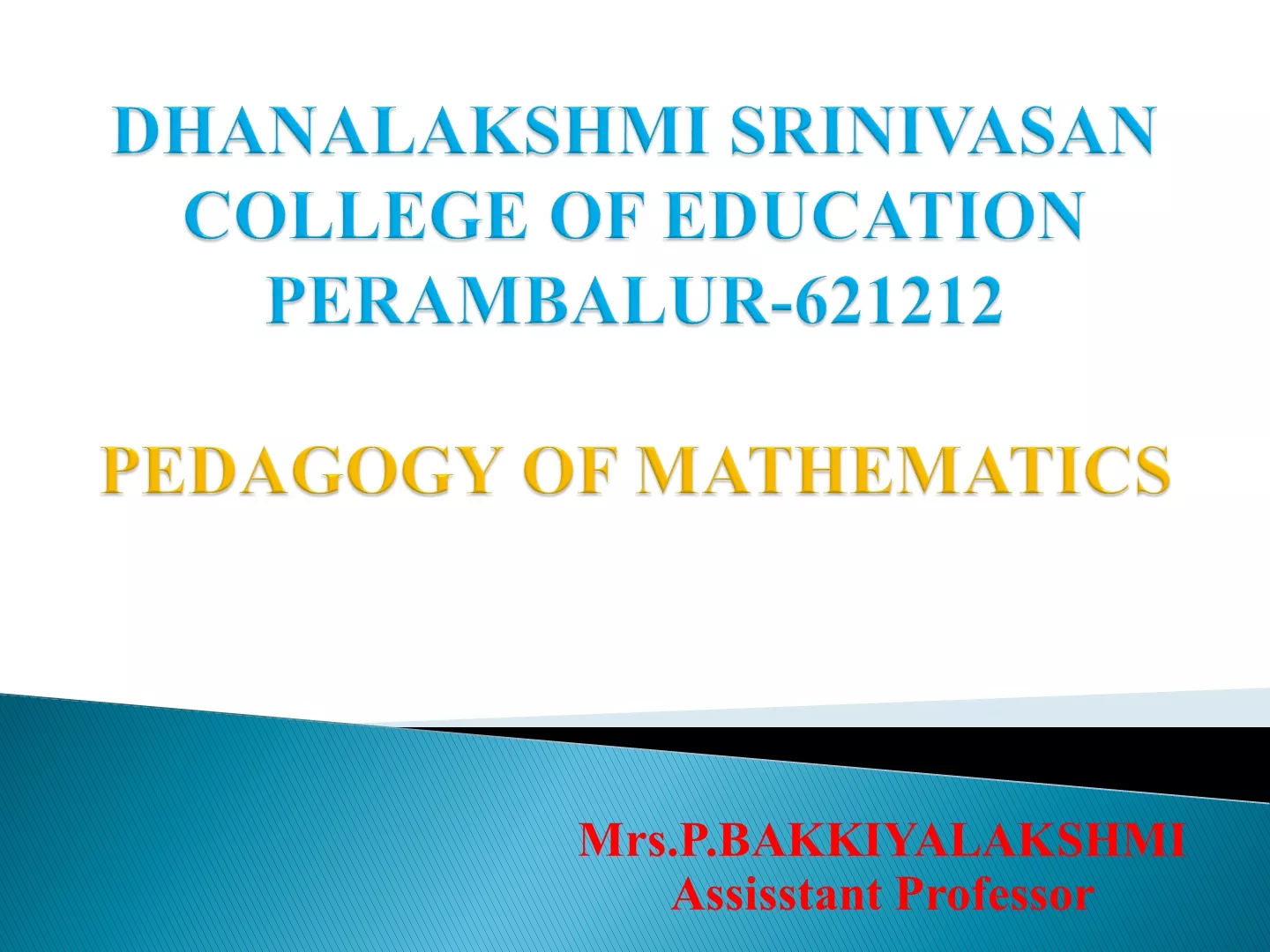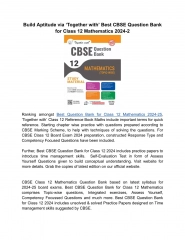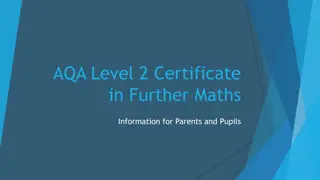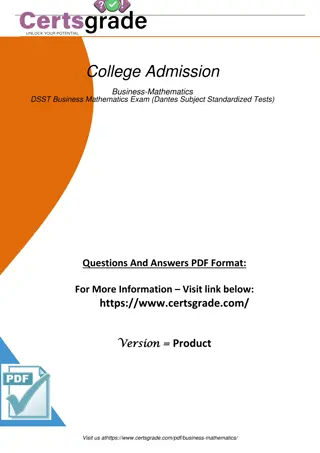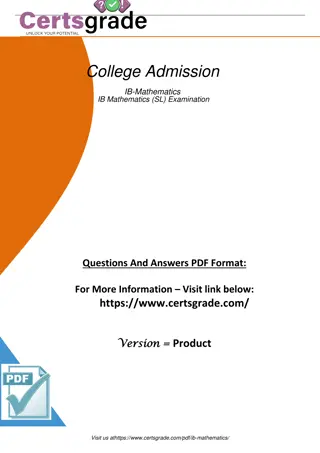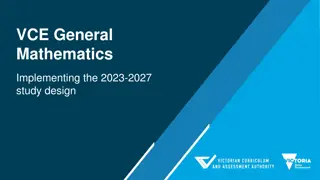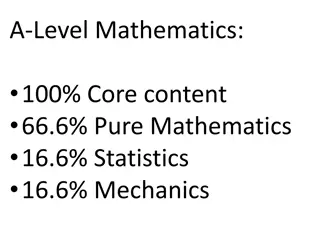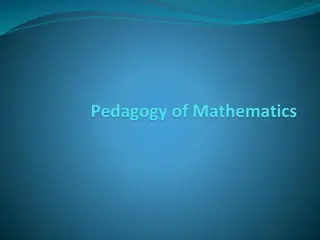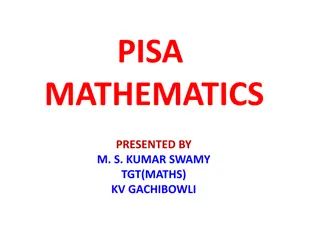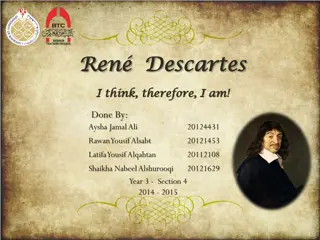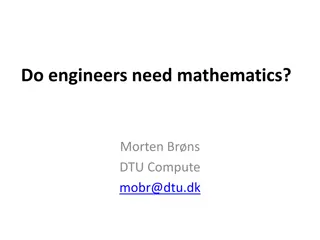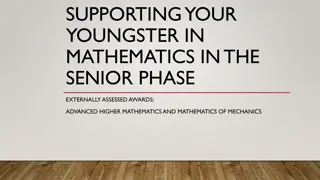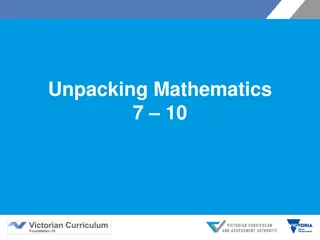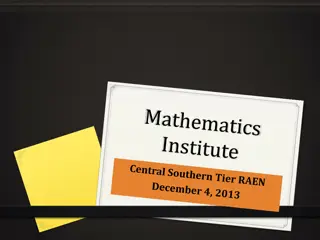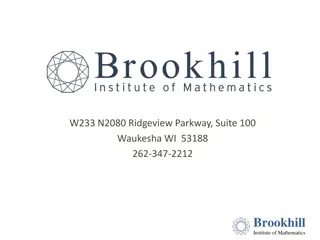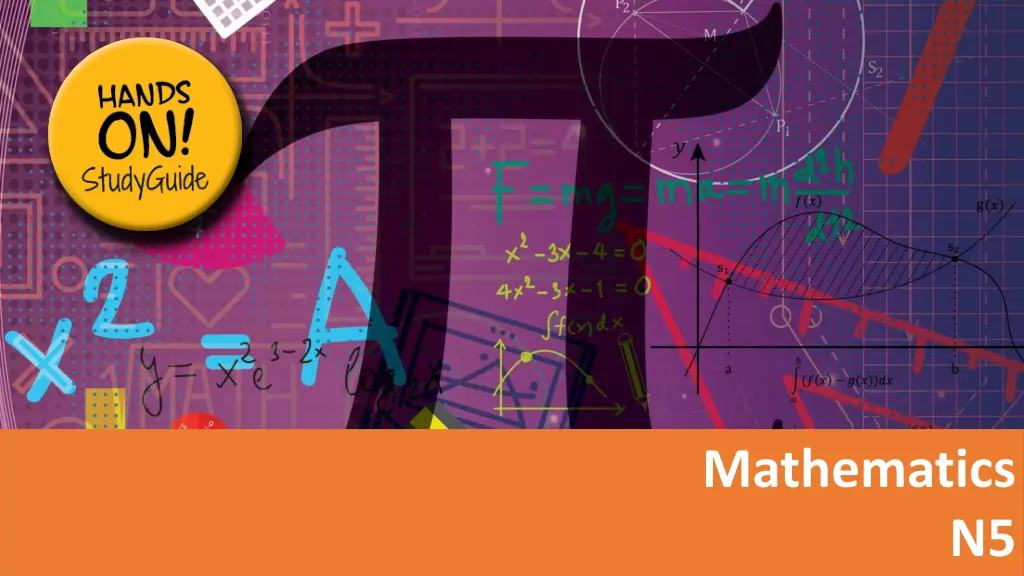
Understanding Mathematics: Limits, Continuity, Differentiation & Applications
Explore the fundamental concepts of mathematics including limits, continuity, differentiation, and their practical applications. Learn about L'Hôpital's Rule, continuity at a point, and differentiation rules and techniques. Discover how differentiation measures the rate of change in functions and Newton's method for approximating irrational roots. Delve into finding maxima and minima, essential in optimizing functions. Enhance your mathematical knowledge with this comprehensive guide.
Download Presentation

Please find below an Image/Link to download the presentation.
The content on the website is provided AS IS for your information and personal use only. It may not be sold, licensed, or shared on other websites without obtaining consent from the author. If you encounter any issues during the download, it is possible that the publisher has removed the file from their server.
You are allowed to download the files provided on this website for personal or commercial use, subject to the condition that they are used lawfully. All files are the property of their respective owners.
The content on the website is provided AS IS for your information and personal use only. It may not be sold, licensed, or shared on other websites without obtaining consent from the author.
E N D
Presentation Transcript
Mathematics N5
Module 1: Limits and continuity INTRODUCTION If ?(?) is defined for all ? near point ? and we can take ?(?) close to L by taking ? arbitrarily close to ?, then we say that ? approaches the limit L as ? approaches a. A function is continuous if its graph can be drawn without picking up the pencil, or more formally, function ?(?) is continuous if the limit of ?(?), as ? approaches ? from either direction, is equal to ?(?).. www.futuremanagers.com
Module 1: Limits and continuity (continued) L H pital s rule The L H pital s rule can be defined as follows: Suppose that the functions ? and ? are differentiable on the interval (?; ?) where ? (?) 0. Then: ? ? ? ? lim ? ? = ? www.futuremanagers.com
Module 1: Limits and continuity (continued) CONTINUITY Continuity at a point is defined when the limit of the function from the left equals the limit from the right and this value is also equal to the value of the function at that particular point i.e. lim ? ?? ? = lim ? ??(?) = ?(?) www.futuremanagers.com
Module 2: Differentiation INTRODUCTION Differentiation in mathematics measures how rapidly these functions change at any point with respect to one of their variables. www.futuremanagers.com
Module 2: Differentiation (continued) DIFFERENTIATION RULES AND TECHNIQUES ? ?+ ? ? = ?? ? = ??? The derivative of a function f is defined by: ? ? = lim Leibniz notation shows: ? ? = ? =?? 0 ??=?? ? ??? ? ??= www.futuremanagers.com
Module 3: Application of Differentiation NEWTON S METHOD TO FIND THE APPROXIMATE VALUE OF IRRATIONAL ROOTS OF AN EQUATION ??+1= ?? ? ??? ? ??for ? = 0,1,2,3,4, www.futuremanagers.com
Module 3: Application of Differentiation (continued) MAXIMA AND MINIMA The maxima and minima (which are the plurals of maximum and minimum respectively) of a given function, which are collectively known as extrema, are the smallest and largest values of a function either in an interval or for the entire domain. www.futuremanagers.com
Module 3: Application of Differentiation (continued) CONCAVITY AND INFLECTION POINT Concavity refers to the inward-curving or hollow object. Inflection point refers to a point of a curve at which a change in the direction of the curve occurs. www.futuremanagers.com
Module 3: Application of Differentiation (continued) APPLICATION OF THE RATES OF CHANGE AND RELATED RATES Related rates problems can be solved by using the following procedure: Define all the symbols you want to use in answering the question. Write down all the relevant equations between the different variables. Differentiate equations to reflect relationship to time and rates of change. State the desired variable in terms of known variables. Substitute values into the equation and simplify. Restate the answer in words to indicate the final result. www.futuremanagers.com
Module 4: Integration techniques INTRODUCTION Integration is used to find the area under the curve on a graph or to find the volume of an object www.futuremanagers.com
Module 4: Integration techniques (continued) INTEGRATION BY INSPECTION 1. Guess the general form of the antiderivative. 2. Take the general form and differentiate it. 3. Compare the differentiated general form with the original integrand. 4. If the general form is correct but the answer is too large or small, put a multiplicative constant into the approximate form. 5. Add the constant of integration to the antiderivative. 6. Differentiate your answer to verify that it gives you the original integrand. www.futuremanagers.com
Module 4: Integration techniques (continued) INTEGRATION BY MEANS OF ALGEBRAIC SUBSTITUTION 1. Find a substitution for ? = ?(?). 2. Find ? = ?(?) (the inverse of ?(?)). 3. Calculate the derivative: d? = ? ? ??. 4. Substitute the functions into the original integrand. 5. Simplify the function using normal algebraic techniques. 6. Check that the new integral is easier than the initial integral. 7. Since ?(?)?? is a function of ?, substitute back to the initial variable ?. www.futuremanagers.com
Module 4: Integration techniques (continued) INTEGRATION OF ALGEBRAIC FRACTIONS 1. Write down the given integral. 2. Come up with a substitution ? = ?(?). 3. Find the inverse function of ?(?), meaning that you will find ? = ?(?). 4. Differentiate to find ?? = ? ? ??. 5. Do not forget that the answer to ?(?)?? is a function of ?. Therefore, once you have finished doing all your calculations, you should substitute back to the initial variable ?. www.futuremanagers.com
Module 5: Application of the definite integral INTRODUCTION When we solve an indefinite integral, the result is mostly another function; when we solve a definite integral, the result is often a numerical value. A definite integral always has a starting point and an end point between which the integral needs to be solved. www.futuremanagers.com
Module 5: Application of the definite integral (continued) SOLVING THE DEFINITE INTEGRAL To determine a definite integral, we can integrate the function as before. Then we substitute the endpoint value into the independent variable of the integrate and subtract the integrate where the independent variable has been substituted with the start point value. www.futuremanagers.com
Module 5: Application of the definite integral (continued) AREAS Whenever we want to calculate the area for a given interval of a function, we can use a definite integral. www.futuremanagers.com
Module 5: Application of the definite integral (continued) VOLUMES OF SOLIDS AND REVOLUTION Volume is the amount of space that a substance or object occupies limited by boundaries on all its sides. Many solids have a circular cross-section in a plane perpendicular to some axis. These solids are referred to as solids of revolution because they are generated by rotating a region 360 about an axis. www.futuremanagers.com
Module 5: Application of the definite integral (continued) SECOND MOMENT OF AREA The second moment of area also known as the moment of inertia of the plane area or the area moment of inertia is the geometric property of an area showing the points distributed randomly along a given axis. The second moment of area is determined with respect to an axis of rotation. www.futuremanagers.com
Module 5: Application of the definite integral (continued) MASS MOMENT OF INERTIA (SECOND MOMENT OF MASS) The second moment of mass is an extension of the moment of inertia to the mass instead of area. The mass moment of inertia can loosely be defined as the property of a body that is central to reluctance of the body to move or accelerate. It can be denoted as: ??= ?2? www.futuremanagers.com
Module 6: Differential equations INTRODUCTION Because derivatives are used to show rates of change, models are usually made up of a function and one or more of its derivatives. These equations are called differential equations (DE) and take the form ?? ??= ? (?) of the function?. www.futuremanagers.com
Module 6: Differential equations (continued) PARTICULAR AND GENERAL SOLUTIONS OF DIFFERENTIAL EQUATIONS The differential equation y = ?(?;?) takes a form which is simple if the function ? is independent of the dependent variable ?: ?? ??= ? ? In this case, we need to integrate both sides of the equation to obtain, (equation 6.1) (equation 6.2) ? = ? ? ?? + ? www.futuremanagers.com
Module 6: Differential equations (continued) SOLVE FIRST ORDER DIFFERENTIAL EQUATIONS There are two ways to find the general solution of the differential equation: 1. Direct integration: ?? ??= ?(?) 2. Separation of variables: ?? ??= ? ? ?(?) www.futuremanagers.com
Module 6: Differential equations (continued) SOLVE SECOND ORDER EQUATIONS Second order differential equations are differential equations that include a second derivative. They use the form: ? ? = ??2? ??2+ ??? ??+ ?? www.futuremanagers.com

